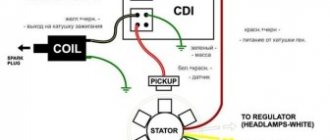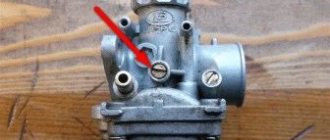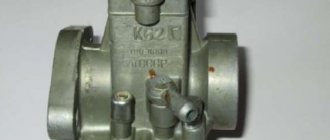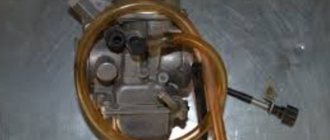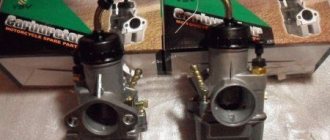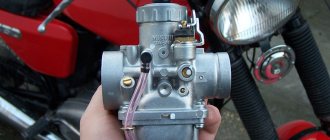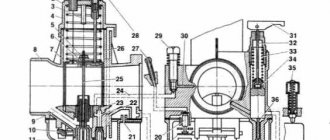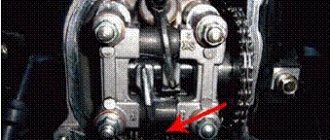The first step before starting the procedure for adjusting the scooter carburetor is to study its structure and operating principle. This way you can quickly and accurately adjust the carburetor on your scooter. A correctly configured carburetor makes it possible to obtain lower fuel consumption, improve dynamic characteristics and completely enable the scooter to start and operate normally. Before the procedure itself, it is important to warm up the engine well; also, if possible, thoroughly clean the entire carburetor from dust and dirt.
Standard carburetor adjustment procedures include the following:
- Idle speed adjustment;
- Adjusting the fuel level in the float chamber;
- Adjustment by adjusting the mixture quality screw on the carburetor;
- Adjusting the mixture quality through the needle inside the carburetor.
Adjusting the carburetor on a 2t scooter: setting it up together
We continue to discuss DIY motorcycle repairs.
The carburetor has been cleaned, the next step is to adjust the carburetor of the 2t scooter. Over the summer, you have to adjust and adjust the operation of the engine several times.
Anyone who is at least a little familiar with the structure of the carburetor will be able to set it up on their equipment themselves. On 2-stroke engines, carburetors are adjusted according to the same principle. Therefore, the topic will be of interest to owners of any brand of 2t 50cc scooters. Whether you have a Honda Dio 27, 34, 35, stroke, Yamaha Jog, BVS or other 2-stroke mopeds.
Carburetor design (video)
For clarity, we suggest watching a video instruction about the design of carburetors and the principle of their operation:
Knowing the structure of the carburetor and understanding what needs to be connected where, you can easily disassemble, reassemble, clean and adjust it yourself, regardless of what brand and model of scooter you have, with some skill. All these procedures will not take much time and will help you save money on car services. The ability to carry them out will help you out when the engine does not want to start.
Diagnostics
Before installing the air filter, turn on the ignition and jerk the kickstarter foot several times until the engine starts.
If it does not start, then the most common reason is that the cold start system is malfunctioning.
We check this way: cover the carburetor hole with your fingers to maximally enrich the mixture with gasoline, and continue to push the kickstarter.
If the engine starts and the speed does not drop during operation, then look for the reason in the cold start system.
If the cold start system is working properly, then after starting the engine the speed will rise and gradually, within 10 minutes, begin to fall. On a warm engine, gradually unscrew the large screw (amount of mixture) until the speed drops to medium, confident idle.
At the same time, drops of gasoline should not splash or pour out of the carburetor.
If gasoline splashes out of the air supply hole, this indicates a malfunction of the reed valve in the engine. Then the valve needs to be removed and cleaned or replaced with a new one.
And if gasoline leaks out, this indicates a high level of gasoline. Adjust the float level and ensure the needle valve is sealed.
Methods for adjusting and tuning a scooter carburetor
The carburetor is an important part, without which the engine will not work. How to set up the carburetor on a scooter determines how smoothly and correctly the engine will run and whether it will be possible to start it in cold weather. The task of this unit is to mix gasoline with air in certain proportions, resulting in the formation of a working mixture, the composition of which determines the behavior of the power unit. The standard ratio should be 1 to 15, if you need the scooter to idle well, you can lean the mixture a little by making 1 to 13; enriched mixture - 1 to 17. For a more in-depth study of the design of a scooter carburetor, we recommend reading the article “The design of a scooter carburetor and the principle of its operation.” Well, now let's learn everything about adjusting the 2-stroke and 4-stroke carburetor of a scooter.
How to adjust the carburetor on a scooter
Knowing how to adjust the carburetor on a scooter, you can get rid of many problems, make sure that the vehicle starts immediately, runs smoothly and does not fail in hot or cold weather. For this, the carburetor, depending on the model, has either only a needle or special adjusting screws.
Adjusting the carburetor on a scooter, if there are adjusting screws, occurs as follows: when the screw is rotated clockwise, the mixture becomes richer, and counterclockwise, accordingly, it becomes leaner.
The procedure must be carried out in the following order:
You also need to take into account little things that may be present on some scooter models, but not on others. For example, before adjusting the carburetor, you need to check the condition of the fuel filter. If it is very dirty, it is recommended to replace it, since even if the carburetor is new and well tuned, a clogged filter will prevent the mixture from flowing in the correct proportion.
The question of how to adjust the carburetor if you have the popular Japanese scooter Honda Dio is quite relevant. Regardless of the year of manufacture and type of carburetor, the scheme described above will suit it.
Idle speed adjustment
Idle speed adjustment plays an important role. When the engine warms up well, you can begin this procedure. To do this, you will need to rotate the adjusting screw clockwise. Its location depends on what model of scooter and carburetor you have. If you don’t know the exact location, find the description instructions for the installed model, where it will be written where which screw is located. For example, on a Honda, the original carburetor has such a screw in the center; on the left side you can find an adjustment for the quality of the mixture.
Adjustment is not difficult: you need to do it with the engine warm and running. When you tighten the screw, the speed will increase, and when you unscrew it, it will decrease. When the engine runs smoothly, you need to stop rotating the propeller. This must be done smoothly, after each change in position, let the engine run a little
Adjusting the mixture quality
Depending on the position of the needle in the carburetor, the percentage of gasoline and oxygen also changes: if there is a lot of air in the mixture, this can be seen by the spark plugs. They will turn black and a characteristic soot will appear. If, on the contrary, there is not enough air, a white coating appears on the candle, and it is clear that the electrode is melting. And this. and that’s not very good for the engine as a whole, not to mention the fact that you will have to change the spark plugs often. Before tuning, you need to unscrew the spark plug and examine its condition, from which you can already build on it, enriching or leaning the mixture.
Not only the operation of the engine, but also its condition depends on the quality of the mixture. For example, with a lean mixture, traction disappears, and with an excessively rich mixture, carbon deposits gradually form in the combustion chamber, which harms the engine. If the carburetor is modern, it has a special screw for adjusting the quality of the mixture, so there is no need to disassemble it. In order to enrich the mixture, the screw must be rotated clockwise; to lean it, rotate it counterclockwise.
The adjustment occurs as follows:
If the carburetor model is old or the screw is missing, in order to debug its operation, you need to get to the needle. In this case, adjustment of the scooter carburetor occurs as follows: there is a special locking ring on the needle. When you raise it up, the mixture will become richer, and when you lower it down, it will become leaner. Typically from the factory the retaining ring is in the middle. Having pulled out the needle with your fingers or tweezers, we move the ring and reassemble the carburetor. After this, you can start the engine and see how it works. If necessary, adjust the settings to perfection using adjustment screws.
Adjusting the fuel level in the float chamber
The fuel level in the float chamber plays an important role. This part is located inside the carburetor, where the process of mixing gasoline with air takes place. In addition to the free reservoir, it contains a float, jets and a needle valve. It is the position of the float that determines when the valve is closed and, accordingly, whether the carburetor will overflow or not. If there is too much gasoline, the engine will start to stall because the spark plug will get wet and the spark will not be able to ignite the mixture.
The reasons why the carburetor on a scooter overflows are usually the following:
The first two problems can be solved by cleaning the carburetor. You cannot use metal objects for this; You can arm yourself with a soft rag. Particular care should be taken when handling jets. The inside can be cleaned with a thin copper wire, but this should be done carefully. The second problem is solved by bending the tongue. It is quite fragile, so you can use your fingernail or tweezers, being careful not to break it. It is easy to check whether the float is positioned correctly: it should be parallel to the body, and not tilt up or down. Then, when fuel enters the chamber in the required amount, the float will rise, and the valve will block the flow of excess fuel into the chamber. Why a scooter carburetor overflows can be found in more detail here.
How to adjust the float in the float chamber on a scooter?
To do this, you need to use a nozzle: it is located at the bottom of the chamber. The screw must be unscrewed, but in such a way as to prevent gasoline from leaving the tube. Usually it is located below the nozzle; if the tube is transparent, it will be more convenient to carry out the work. In order to see the fuel level, it must be raised vertically.
At a normal fuel level, gasoline does not reach the curb of the carburetor cover, at a higher level it begins to overflow, at a lower level the scooter rides poorly and nods. To adjust, you will need to disassemble the carburetor, find the needle inside the float chamber, there is a locking ring on the needle, it needs to be moved down.
Idle speed adjustment
Does your scooter not work properly when idle and often stalls? Most likely your idle speed screw is not adjusted sufficiently. Before the procedure, be sure to warm up the engine, then find the idle screw, which is present on absolutely all scooters. You will have to warm up the scooter for 10-15 minutes, this will allow you to achieve optimal engine performance.
After this, you need to turn the idle speed screw, where clockwise rotation increases the speed, and unscrewing it decreases it.
Features of setting up the carburetor of a 2-stroke scooter
The carburetor on the 2t scooter is slightly different in design and does not fit the 4t motor. The question of how to set up such a device worries all owners of two-stroke machines.
Most Chinese models have a fairly simple carburetor without unnecessary adjustments. The enrichment here is mechanical, although if you are tuning a scooter or you have a Japanese model, the enrichment can also be electric. In order to use the mechanical option, you must first pull the trigger on it, and then try to start the equipment.
Adjusting the carburetor of a 2T scooter is not difficult, but it does require some patience. In order to do this, you will need to disassemble the carburetor: first you will need to unscrew the top cover. The needle in it is fixed with a staple; it needs to be pulled out. The quality of the mixture is adjusted in the same way as described above. A feature of the push-pull system is that the needle affects the quality of the mixture only in a certain position. If the throttle valve is raised to its maximum, only the main fuel jet will be responsible for the fuel mixture. Sometimes the idle speed system interferes with it. Depending on what carburetor you have installed.
For a cold start, you need to use a starting enrichment, which must be closed after the engine warms up; Simply put, it's a suction. In such carburetors, the fuel level plays an important role. It is also regulated by mechanical intervention in the operation of the float chamber. It is configured in the same way as in the four-stroke version. In fact, the carburetor for 2t engines differs from models for engines on a 4-stroke scooter only in jets and some other parameters, but it is designed similarly, and therefore is regulated in the same way.
Adjusting the fuel level
The float chamber allows you to have a constant flow of fuel in the carburetor, which is always replenished, but it is important to remember that you cannot have an excess of gasoline in the float chamber. Gasoline is drained using a special hose coming from the chamber; you will have to check the amount of fuel with the engine running. Raise the hose above the carburetor as shown in the picture below and check the fuel level. It should not differ much from the mark indicated in the picture. There is a holder antenna located on the needle inside the float chamber; it can be used to regulate the amount of fuel inside the float chamber.
Please also take into account the fact that before adjusting the carburetor, you should only have high-quality gasoline with a normal octane number. Otherwise, you will have to completely drain the bad gasoline not only from the gas tank, but also from the float chamber; it must have a special drain screw.
Features of tuning the carburetor of a 4-stroke scooter
Adjusting the carburetor of a 4t scooter is quite possible with your own hands and should not cause any difficulties, the main thing is to act according to the instructions described above. It’s not always possible to adjust; the carburetor on a 4t scooter works right away. You will have to be patient: you may have to repeat the procedure several times until you get a result that suits you. The smooth operation of the engine, the ability of the vehicle to start in cold weather, and what kind of piston wear will depend on how to correctly configure the carburetor in a 4t scooter.
4T scooters are usually equipped with similar carburetor models, so the VLC carburetor adjustment scheme described above is also applicable to other types of devices.
